
Cheryl Groskopf, LMFT, LPCC
Holistic Anxiety, Trauma, and Attachment Therapist in Los Angeles
Attachment Therapist Los Angeles
5 Key Signs of Fearful Avoidant Attachment in LA, Part II
Feeling stuck or overwhelmed? I get it. I’m Cheryl Groskopf, a Los Angeles-based therapist specializing in attachment, trauma, and anxiety. I’m here to help you understand the signs of fearful avoidant attachment with a compassionate and practical approach.
In today’s post, I’ve broken down an additional 5 signs associated with fearful avoidant attachment into simple, relatable examples, showing how childhood experiences affect your adult relationships. You can check out Part I of this blog by clicking here! If these signs resonate with you, and you’re thinking about therapy, know that it’s a brave and powerful step.

IIdentifying Fearful Avoidant Attachment in Los Angeles: A Therapist's Guide Pt 2
1. High Levels of Anxiety and Stress with Emotional Vulnerability
Let’s start this off with an example:
Let’s say there’s a child raised in an environment where showing vulnerability was discouraged or met with indifference. If they shared something personal or showed emotional pain, it was ignored or criticized. This child learns a harsh lesson: revealing their true self, especially the parts that are raw and tender, leads to discomfort or rejection. The natural human need to seek comfort and connection is then immediately denied because they have learned that vulnerability = weakness and potential pain. In response, the child starts to guard their emotions closely, and begins to experience apprehension during potential intimacy.
In adulthood, this individual often experiences anxiety and stress at the slight idea of being emotionally vulnerable (or engaging in relationships that demand a deeper level of intimacy). This isn’t because they don’t desire close connections (it’s actually the opposite). They might deeply desire such relationships, but the fear of being hurt or exposed keeps them in a state of high alert. Situations that require opening up or showing their emotions (including fears, discussing future plans with a partner, or expressing love) trigger a sense of vulnerability that quickly leads to anxiety. What does this look like when it happens? Avoiding deep conversations, withdrawing when a relationship gets too intense, or sabotaging connections that get too close.
The cycle of craving intimacy, but also being overwhelmed by the vulnerability, is a common experience for fearful avoidant attachers. It stems from early experiences where vulnerability was not safe, which teaches the child to associate emotional vulnerability with negative outcomes. Understanding this pattern can help you develop the self-compassion you need to heal. Recognizing that the defenses and walls built in childhood (though once were necessary for emotional survival) now impact the ability to form fulfilling, intimate relationships. Addressing this requires patience and professional guidance to slowly build trust in the safety of vulnerability. The goal is to learn that intimacy, even with all of the potential risks, can also bring connection and joy. And i think we all can use a little bit more of that.

2. Difficulty Forming and Maintaining Long-term Relationships
Okay, let’s keep the scenarios going. Let’s imagine a scenario where a child experiences frequent disruptions in their caregiving environment, like a parental separation, divorce, or even the loss of a caregiver. This child learns early on that relationships can be unstable. This instability might can be both physical and/or emotional. By being raised by caregivers who are emotionally unavailable or inconsistent in their affection and support, the child adapts to the unpredictability by holding back emotionally. This helps them to protect themselves from the pain of loss or rejection. They might become highly self-reliant and believe that depending on others for emotional support will always lead to disappointment.
As an adult, the individual faces challenges in building and maintaining long-term, secure relationships. Their belief that relationships are unstable can make it difficult to commit, sabotaging relationships that become too close, or withdrawing emotionally when a relationship reaches a certain depth. On the surface, these behaviors can seem “strong” and independent – but at their core, they’re driven by fear. Fear of experiencing another loss or emotional abandonment they felt in childhood. This fear makes it difficult to fully be present in relationships, and almost impossible to be truly seen by others.
If you’re recognizing this pattern in your life, the journey toward change involves exploring these attachment fears. It’s about learning to trust in the potential for stability and security in relationships, and gently challenging the belief that ALL closeness leads to hurt. This process often requires navigating vulnerabilities with intention and support. Therapy is a great place to do this because it sets you up in a safe place, where you can explore and heal these early wounds. Gradually, it becomes possible to engage in relationships not from a place of fear, but from a place of hope and trust.

Fearful Avoidant Attachment: AN Internal Struggle
3. Fear of Being “Engulfed” or Overwhelmed
Imagine a child raised in an environment where boundaries were not respected or were inconsistently set. This could look like caregivers who don’t provide their children a sense of privacy and being overly intrusive, while also being emotionally distant. This is SO confusing for a child. These experiences teach the child that closeness = a loss of self because their feelings, thoughts, and desires are flooded by their caregiver. To cope, the child learns to protect and guard their personal space fiercely, and begins to see solitude as a way of feeling safe, and feeling like they have control over their environment.
In adulthood, this individual often shows up as fearing being flooded by the needs, desires, or personalities of others – especially in close relationships. This fear can manifest as a strong need for personal space and firm boundaries to the extent that it hinders relationships from evolving. While they may desire connection and intimacy, the thought of losing their autonomy or being ‘consumed’ by another person triggers anxiety. This causes them to put up a wall or withdrawal completely. In romantic relationships, this might look like being hesitant to share living spaces, feeling reluctant to share activities, or a preference for maintaining separate social circles. Their protective need for space and boundaries is not an “allergic reaction” to closeness, but is actually a learned response to the fear of losing their identity.
If you can relate, then recognizing that this fear is stemmed from past boundary violations or intrusions can be SO important for healing and growth. Therapy can help. It involves learning to navigate the balance between closeness and personal autonomy, while also understanding that healthy relationships can be intimate without impacting individuality. By working with an attachment therapist in Los Angeles, you can work to establish boundaries that protect you without isolating, but also a space for creating connections that honor both “togetherness” and “separateness.”

4. Avoiding or Withdrawing from Emotional Intimacy and Closeness in Relationships
In a scenario where a child experiences emotional neglect, or inconsistent emotional availability from caregivers, they quickly learn to hide or “guard” their feelings as a means of self-protection. For example, if the child tries to initiate affection or share their emotions, they’re be met with disinterest, rejection, or inconsistency (aka warm affection one moment and cold detachment the next, i.e. Cold Mother Syndrome). This inconsistency sends a confusing message that teaches the child that emotional intimacy is unreliable and potentially hurtful. As a defense mechanism, they begin to withdraw emotionally and subconsciously believing that keeping a distance is safer than the pain of rejection and/or inconsistency.
In adult relationships, this can manifest into avoidance of emotional intimacy and closeness. Despite a deep desire for connection, they often pull away when relationships reach a sense of closeness. This isn’t a conscious choice. It’s actually an adaptive defense against the perceived threat of emotional vulnerability. They might avoid deep conversations, withhold affection, or sabotage relationships that become too close for them. This behavior is driven by a deep fear of experiencing the emotional neglect or inconsistency they had in childhood. And although this may have protected them as children, it creates a cycle of loneliness and disconnection in adulthood.
This consistent avoidance of emotional intimacy while also desiring closeness is a common sign of fearful avoidant attachment. It’s rooted in your early experiences with caregivers who were emotionally unavailable or inconsistent. Recognizing this pattern is the first step toward of a journey of healing + forming deeper, more meaningful connections. The process involves exploring fears of vulnerability, learning to trust in the safety of emotional closeness, and gradually disarming the protective walls built in childhood. Through therapeutic work, self-reflection, and consistently showing up for yourself every week, you can begin experiencing relationships that embrace emotional intimacy- and not see it as weak

People Pleasing Isn't Just for Insecure Attachers
5. Avoidance of Conflict and Difficult Conversations
Imagine a child who grew up in a household where conflict is either handled through intense arguments or COMPLETE silence, with absolutely zero resolution. An environment where conflict management was never modeled to them. This child learns that conflict is dangerous, potentially leading to emotional distance or even the loss of a relationship. To navigate their environment, the child adopts a strategy of avoidance by suppressing their own needs, opinions, and feelings to maintain a sense of peace. They might also become a people pleaser by constantly bending over backwards to meet the needs of others at the expense of their own. They truly believe that this will keep them safe AND connected.
But as an adult, this individual continues to shy away from conflict and difficult conversations in their relationships. This avoidance isn’t because they don’t care or are not invested in the relationship, but is actually a fear of potential rejection or abandonment if there’s conflict. This ends up looking like giving up their own preferences if someone disagrees, suppressing their desires to maintain the peace, or completely refraining from expressing concerns to avoid ‘rocking the boat.’ In extreme cases, this can lead to a pattern of ‘fawning’. Fawning is a trauma response rooted in pleasing others to feel safe. While this behavior might temporarily keep the peace, it often leads to internal resentment, unmet needs, and a sense of disconnection from one’s authentic self.
The tendency to avoid conflict and people-pleasing are often associated with insecure attachment, but can also be a sign of fearful avoidant attachment. Acknowledging this pattern is the first step toward change. It opens the door to learning healthier ways of communicating your needs within relationships. The journey involves understanding that conflict, when approached in a healthy way, is not a threat to relationships. Conflict management in relationships can actually be an opportunity for growth and deeper connection. Developing skills in assertive communication and boundary-setting can help transform fear of conflict into confidence.
Meet Cheryl Groskopf, LMFT, LPCC
Recognizing these signs is just the beginning. Real change comes from taking the next step – seeking help and guidance. As a highly rated attachment therapist in Los Angeles, I’m here to support you on this journey. In my practice, we’ll work together to explore the complexities of your attachment style, build healthier relationship patterns, and gain access to your authentic self that’s grounded in security and confidence.
If you see yourself in these signs and examples, and are ready to transform your relationships, I encourage you to reach out. Therapy is a powerful tool, and with the right support, you can rewrite your story to one of resilience, connection, and emotional well-being.
In my therapy sessions, we’ll work together to uncover the roots of your struggles and find effective ways to move forward. If you’re ready for a change and want to feel more connected and confident in your life, let’s talk.
Let’s take that first step together!
Additional blogs On Attachment Therapy
Additional Resources About Fearful Avoidant Attachment
- “The Power of Attachment: How to Create Deep and Lasting Intimate Relationships“ by Diane Poole Heller
- Attachment Theory in Practice: Emotionally Focused Therapy (EFT) With Individuals, Couples, and Families” by Susan M. Johnson
- “Attached: The New Science of Adult Attachment and How It Can Help You Find—and Keep—Love“ by Amir Levine and Rachel Heller. You can also check out the New York Times article by clicking here!




